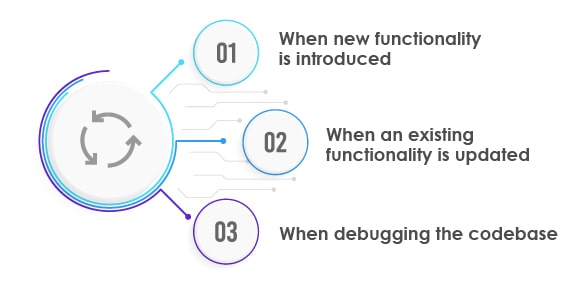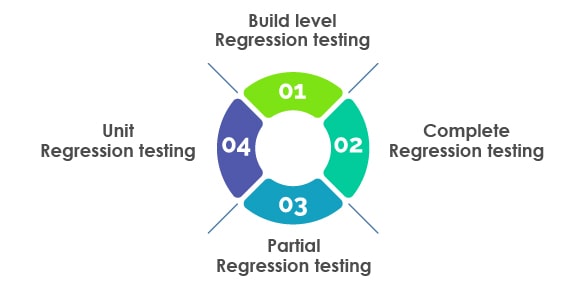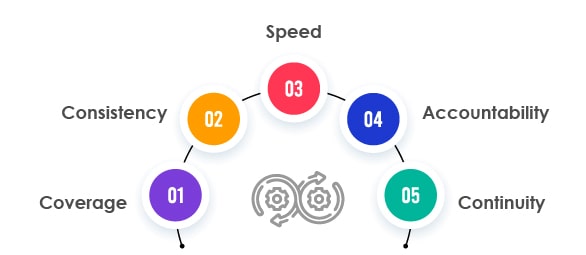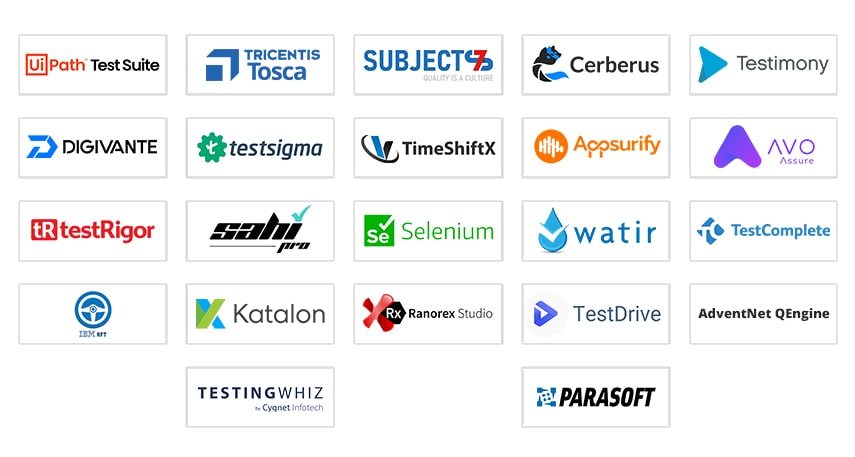Published: 23 Jun 2022
Role of Regression Testing in DevOps – A Quick Guide
Last Updated: 29 Mar 2024
Content
1. What is DevOps Regression testing?
2. Benefits of embedding DevOps Regression testing
3. Ideal DevOps Regression testing scenarios
4. How did Conventional Testing Work?
5. Where does Regression testing fit in DevOps?
6. Various Regression testing methods that fit in DevOps
7. Five key elements of the Regression test plan in DevOps
8. How to Perform Regression Testing?
9. Top 22 Regression testing tools in 2023
10. Conclusion
Digital companies utilize DevOps methodologies to more quickly bring products and services to customers with higher quality, more frequent releases. While delivering new versions at a faster pace, regular updates are implemented to continuously enhance how users interact with applications. In this rapid effort to efficiently produce top-performing software, regression testing guarantees that any code modifications do not compromise current features. Therefore, regression testing as part of DevOps confirms the application continues to operate flawlessly despite continuous code alterations.
What is DevOps Regression testing?

When digital businesses expand their DevOps ecosystems, the speed of product changes and tweaks increases as well. Regression testing confirms that even as updates happen quickly, everything continues to function as anticipated. This provides tremendous benefits to companies using DevOps.
Benefits of embedding DevOps Regression testing

• Effective Regression testing embedded in DevOps enhances the overall product quality and ensures a great user experience (UX).
• Facilitates the creation of a stable product as testing is performed in sprints.
• Highlights functional defects early in the development life cycle for faster resolution
• Automated Regression testing shrinks re-work, and QA engineers will be freed up to take up other critical activities.
• Automated Regression testing in a DevOps environment ensures the releases are lightweight and efficient by reducing the test execution cost and time while optimising the application quality.
Ideal DevOps Regression testing scenarios

In an ideal DevOps scenario, it should be considered to perform Regression testing whenever the codebase undergoes modification or change in some way. Here are a few scenarios when Regression testing enables a perfect balance between continuous development and continuous testing within a DevOps environment.
When new functionality is introduced:
Introduction of any new functionality demands running Regression tests. There is always a risk of unexpected compatibility issues when modifications are made to the code. After the modifications are made, reviewing every code thread for compatibility is time-consuming. Hence, Regression testing is performed to save time with early and quick bug detection.
When an existing functionality is updated:
Sudden shifts in business strategy can sometimes lead to a complete revision of the existing features of the application. In this case, Regression testing in DevOps enables the developers to adjust, optimise, or even re-look at the features and ensures to keep the overall application in place.
When debugging the codebase:
Fixing a bug can unexpectedly lead to the generation of more bugs in the codebase. While debugging the source code within DevOps, Regression testing ensures that bug fixes do not cause more issues and ensures everything works as intended.
Given the above scenarios where Regression testing plays a critical role in ensuring bug-free deployment, let us now see where Regression testing fits in a DevOps workflow.
How did Conventional Testing Work?
Conventional testing, also known as traditional testing, follows a structured and systematic approach to assess the functionality and quality of software or products. The process typically begins with the creation of detailed test plans that outline the scope, objectives, and methodologies of testing. Test cases are then designed based on specifications and requirements to evaluate various aspects of the system. During the execution phase, these test cases are run, and the outcomes are compared against expected results.
Defects and issues are identified, reported, and then addressed by development teams. Conventional testing relies heavily on manual efforts, where human testers simulate end-user interactions to identify bugs and potential areas of improvement. While this method has been effective for many years, it can be time-consuming and resource-intensive, leading to the evolution of more automated and agile testing approaches in recent times.
Where does Regression testing fit in DevOps?

Regression testing has a key role to play in a DevOps workflow. This process takes place in the following instances:
• When product enhancements are done
• When new patches added
• When there are minor changes in the software configuration
• When a new feature is added, leading to code modification
• When updates are made to the existing functionality or a patch fix
• When integration with other apps takes place
• When there are code changes to upgrade performance
Various Regression testing methods that fit in DevOps

Build level Regression testing:
Occurs during the second build of an upcoming release and enables the verification of the behaviour and compatibility of a newer version of the software.
Complete Regression testing:
Helps the testers to restore possible modifications done while extensive updates are made to the existing code.
Partial Regression testing:
Ensures the application performs as intended when new snippets of code are added to the existing code.
Unit Regression testing:
Enables the testers to test the code as a single unit. Unit Regression testing follows a narrow and focused approach in which all the complex interactions and external dependencies are temporarily blocked.
Five key elements of the Regression test plan in DevOps

After knowing the significance of Regression testing in DevOps, businesses should know about the key Regression test plan elements for careful planning of resources and channelizing QA efforts in the right direction.
Coverage:
It is not possible to declare what parts of the software need Regression testing without a test plan to refer to. Coverage can be measured by lines of code, statements, functions, or use paths. QA teams should use a code coverage report that showcases how much code has been covered by unit tests. Although it may measure the quality of tests, this report can determine which parts of the code need additional testing.
Consistency:
The entire application should be tested end-to-end when performing Regression testing. QA engineers must ensure that different app segments are tested consistently using the same tests and variables to generate the same output. Thus, following a consistent test plan makes Regression testing faster while ensuring test accuracy and quality of the application.
Speed:
A good Regression test plan will feature all the necessary details of testing laid out systematically and is easy to understand and execute. This accelerates the Regression testing procedure and improves the speed of the overall process.
Accountability:
A respective stakeholder, i.e., a QA lead or a senior QA, may be assigned for each sprint which takes ownership of the recorded tests and shares the approval for further production. When accountability is assigned to reliable stakeholders, it ensures effective Regression testing.
Continuity:
An effective test plan should document all the necessary details of recreating the test environment, performing the test and measuring the results. Thus, the test plan should be made accessible to all the involved team members.
How to Perform Regression Testing?
Performing regression testing involves systematically verifying that new changes or updates to a software application do not negatively impact existing functionalities. Here’s a step-by-step guide on how to perform regression testing:
Identify Test Scenarios:
Review the software’s existing test cases and identify critical test scenarios that cover the core functionalities of the application. These scenarios act as a baseline for regression testing.
Create Regression Test Suite:
Based on the identified test scenarios, create a regression test suite, which is a collection of test cases that will be executed during regression testing. This suite should cover the most critical and commonly used features of the software.
Automate Test Cases (Optional):
If feasible, consider automating the regression test suite using testing tools. Automation can significantly speed up the testing process and increase test coverage for repetitive scenarios.
Execute Test Cases:
Run the selected test cases in the regression test suite against the new version of the software. Ensure that the test environment is appropriately set up to replicate the production environment as closely as possible.
Compare Results:
Compare the test results of the new version with the expected results from the baseline test scenarios. Identify and document any discrepancies or defects found during testing.
Defect Reporting:
When discrepancies are identified, create defect reports, including detailed information about the issue, steps to reproduce it, and any supporting documentation. Assign the defects to the development team for resolution.
Defect Resolution:
The development team works on fixing the reported defects, and the fixes are then retested to ensure they have been successfully addressed.
Regression Test Iteratively:
If additional defects are found and fixed, rerun the regression test suite after each round of defect resolution. This iterative process continues until all critical issues are resolved, and the software meets the required quality standards.
Expand Test Coverage:
As the project progresses, consider expanding the regression test suite to include additional test cases that cover newly added features or functionalities.
Maintain Regression Test Suite:
Regularly update and maintain the regression test suite to reflect changes in the software and ensure that it remains an effective tool for validating software updates.
By following these steps, regression testing helps ensure that the software remains stable and reliable, even after introducing changes or updates, and provides confidence in the application’s overall quality.
Top 22 Regression testing tools in 2023

• UiPath Test Suite
• Tricentis TOSCA
• Subject7
• Cerberus Testing
• Testimony
• Digivante
• Testsigma
• TimeShiftX
• Appsurify TestBrain
• Avo Assure
• testRigor
• Sahi Pro
• Selenium
• Watir
• TestComplete
• IBM Rational Functional Tester
• Katalon Studio
• Ranorex Studio
• TestDrive
• AdventNet QEngine
• TestingWhiz
• WebKing
Conclusion
In today’s digital landscape, businesses in the United Kingdom (UK) strive to deliver faster, high-quality releases that provide an exceptional customer experience. Therefore, it is necessary to ensure high-quality products that effectively meet the customer expectations, which is achieved by leveraging software testing right from the stage of product development. Adopting effective regression testing in Agile ensures timely delivery of high-quality products to the market as all features are tested end-to-end.
How Can TestingXperts Help?

Regression testing is a key area of focus for TestingXperts (Tx) in the UK. TestingXperts’ spectrum of regression testing services include:
• Software Regression Testing
• System Integration Regression Testing
• Functional Regression Testing
• Automated Regression Testing
• End-to-End Regression Testing
Our cost-effective regression testing model helps QA teams to deliver a reasonable balance between test selection and fault detection. Leverage our next-gen regression testing services for quality products.
Our regression test automation services have saved time & effort, lowered overall QA costs up to 60% and reduced QA cycle times by 80% for our clients.
Talk to our QA experts today